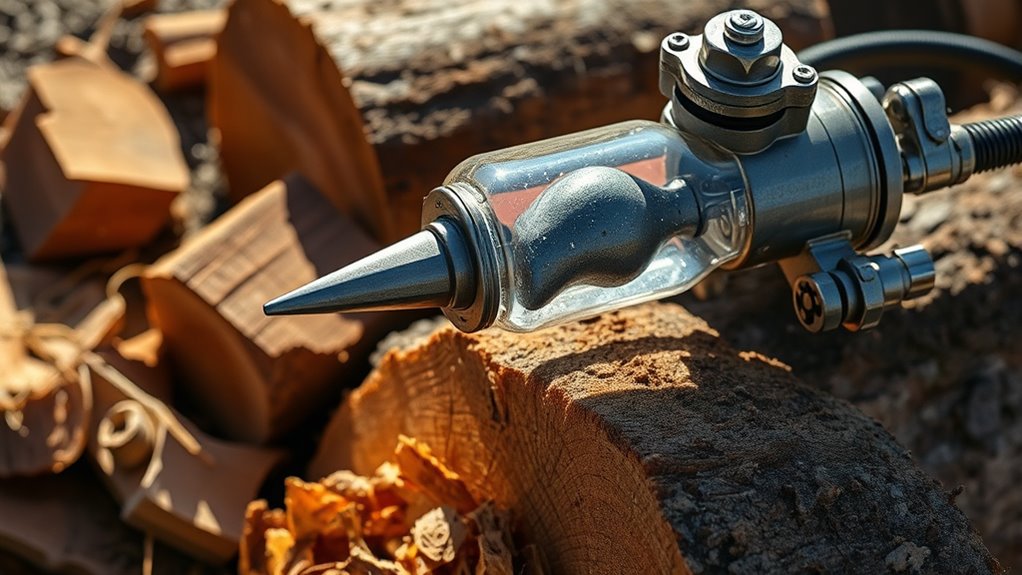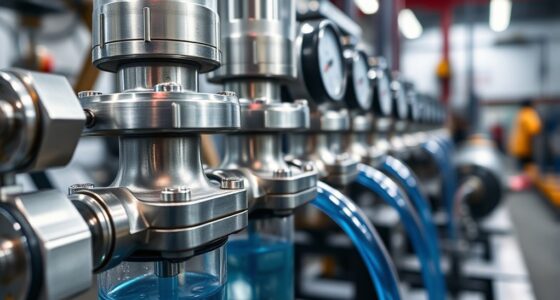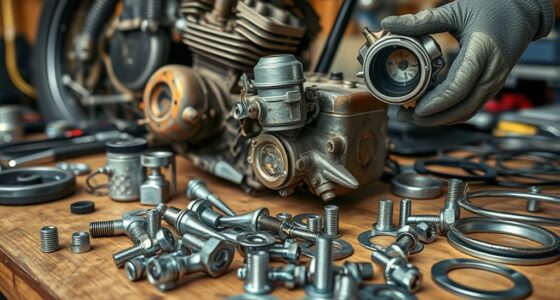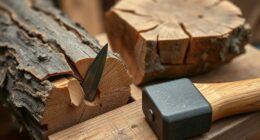Hydraulic log splitters work by using a hydraulic pump to pressurize fluid, which then moves a piston inside a cylinder. As the piston extends, it pushes a wedge into the log, applying force to split it apart. Control valves regulate the flow and pressure for smooth operation, while safety features guarantee secure use. If you’re curious about how each part functions together, keep exploring to discover more about this efficient machine.
Key Takeaways
- Hydraulic log splitters use pressurized fluid to move a piston that applies force to split logs.
- A hydraulic pump generates high-pressure fluid from a reservoir, powering the system.
- Control valves regulate fluid flow, controlling piston movement and speed for efficient splitting.
- The piston pushes a wedge into the wood, applying force to split logs along the grain.
- Safety features like valves, shields, and controlled operation prevent accidents during use.
Basic Components of a Hydraulic Log Splitter
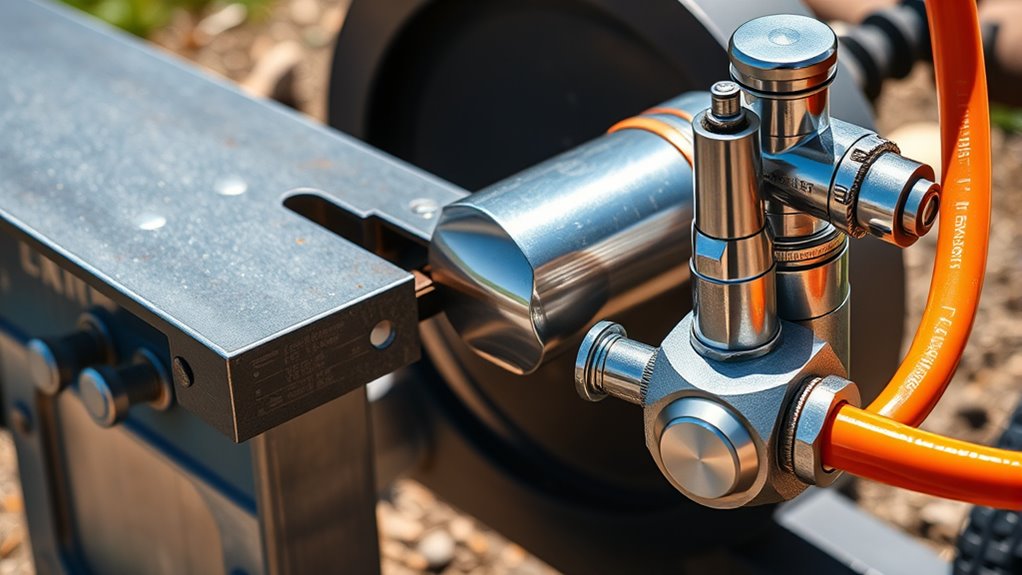
A hydraulic log splitter relies on several key components working together to make splitting logs easier and more efficient. First, the hydraulic cylinder is essential, as it provides the force needed to push the splitting wedge into the wood. You’ll also find the wedge itself, which directs the splitting action. The hydraulic fluid acts as the power transfer medium, flowing through the system to generate pressure. The control valve allows you to operate the splitter, controlling the movement of the hydraulic fluid and the cylinder. Ultimately, the frame and base give stability and support, keeping everything aligned during operation. These components work seamlessly together, transforming hydraulic pressure into the powerful force required to split logs quickly and safely.
The Role of the Hydraulic Pump
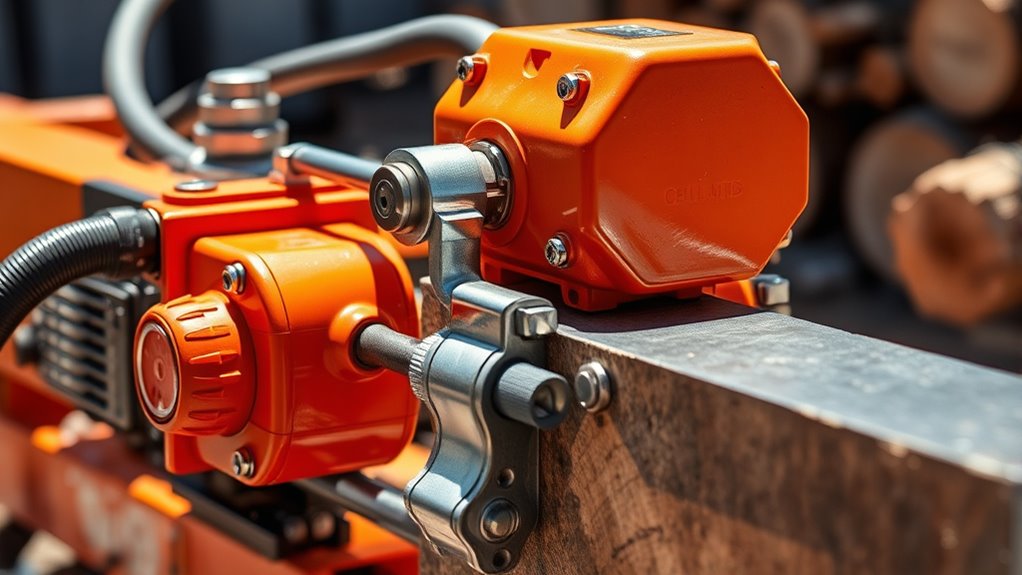
The hydraulic pump is essential for powering your log splitter by generating the pressure needed to move the hydraulic fluid. It creates this pressure through a specific process that transforms mechanical energy into hydraulic energy. This power is then transmitted to other components, making the splitting action smooth and effective.
Hydraulic Pump Functionality
Ever wondered how hydraulic log splitters generate the force needed to split logs? It all starts with the hydraulic pump. The pump’s job is to convert mechanical energy, usually from a motor, into hydraulic energy by moving hydraulic fluid. As the pump operates, it creates a flow of pressurized fluid that travels through hoses to the cylinder. This pressurized fluid is vital for powering the system. The pump maintains a steady flow, ensuring the fluid reaches the cylinder with enough force to push the splitting wedge. Without the pump, there’s no way to generate the hydraulic pressure required for splitting. Its efficiency and reliability are essential, because they directly influence how well the log splitter performs under different loads.
Pressure Generation Process
How exactly does the hydraulic pump generate the pressure needed to split logs? It does this by converting mechanical energy into hydraulic energy. When you activate the pump, a motor drives its internal components, creating a flow of hydraulic fluid. This fluid is pushed through the system under high pressure, thanks to the pump’s design, such as a gear, vane, or piston mechanism. As the fluid moves through the hoses and into the cylinder, it exerts force on the piston. This force builds up quickly, creating the pressure required to move the hydraulic ram. The high-pressure fluid then powers the piston, which applies force to the log, splitting it apart efficiently.
Power Transmission Method
Hydraulic pumps serve as the central component that transmits power within a log splitter. When you activate the splitter, the pump draws hydraulic fluid from the reservoir and converts mechanical energy into hydraulic energy. It then pushes this pressurized fluid through hoses and valves toward the hydraulic cylinder. This flow of fluid creates the force needed to drive the ram forward, splitting the log. The pump’s efficiency directly impacts the splitter’s performance, making it a critical part of the system. You can think of the pump as the heart of the hydraulic system, controlling how much power is delivered and when. Without the pump, the hydraulic fluid wouldn’t move, and the splitting process wouldn’t occur. It’s essential for converting your motor’s energy into effective splitting action.
Understanding Hydraulic Cylinders

A hydraulic cylinder is a key component that converts pressurized fluid into linear motion, enabling the powerful movement needed to split logs. When hydraulic fluid enters the cylinder through a port, it pushes against a piston inside, creating force. This force moves the piston rod outward, applying pressure to the log. As the piston extends, it produces the thrust required to split wood apart. When the operation is complete, releasing the fluid allows the piston to retract, resetting the system. Hydraulic cylinders come in various sizes and designs, but their core function remains the same: transforming fluid energy into mechanical force. This simple yet effective mechanism makes hydraulic log splitters efficient, reliable, and capable of handling tough, thick logs with ease.
How Hydraulic Fluid Creates Pressure
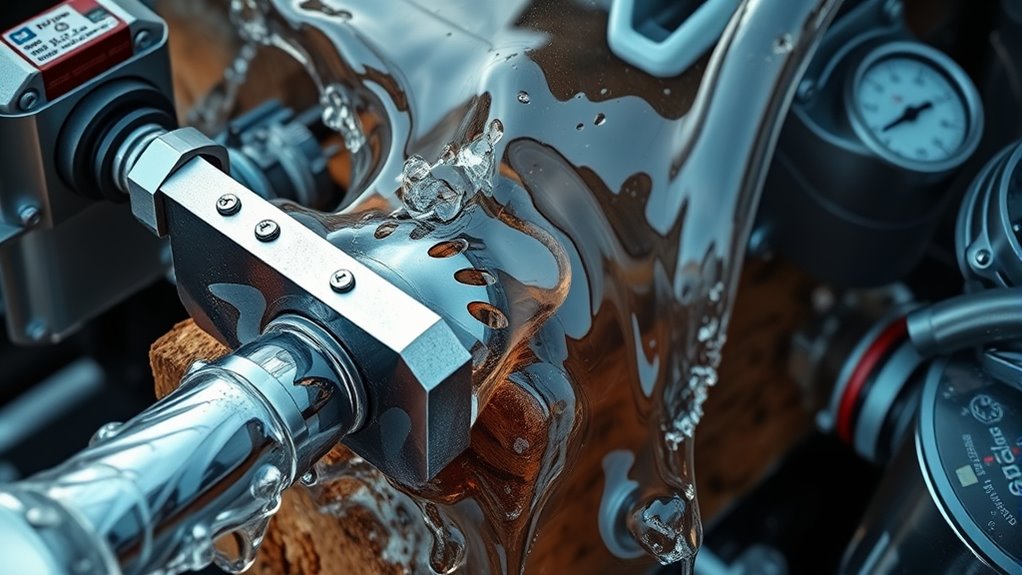
When you operate a hydraulic log splitter, the hydraulic fluid is compressed within the system, creating pressure. This pressure follows the principle that it’s transmitted equally throughout the fluid, no matter the shape of the container. Understanding how fluid compression mechanics and pressure transmission work is key to grasping how your splitter powers through logs.
Fluid Compression Mechanics
Fluid compression mechanics rely on the principle that liquids, unlike gases, are nearly incompressible under normal conditions. When you operate a hydraulic log splitter, you activate the pump, which moves hydraulic fluid into a cylinder. As the piston begins to push, it compresses the fluid within the cylinder. Because liquids are nearly incompressible, the volume of fluid remains constant, but pressure increases rapidly. This pressure builds up because the fluid has little room to move, transmitting force directly to the piston. The result is a high-pressure force that drives the splitting wedge into the wood. You don’t need to worry about compressing the fluid itself; instead, the minimal compressibility allows the force to be transmitted efficiently and instantly, enabling powerful and precise splitting action.
Pressure Transmission Principles
The high-pressure force generated in a hydraulic log splitter depends on how the hydraulic fluid transmits pressure throughout the system. When you activate the splitter, a pump pushes fluid into a cylinder, creating pressure. This pressure is transmitted equally in all directions, thanks to Pascal’s Law, meaning it acts uniformly on the piston. As the fluid fills the cylinder, it exerts a force on the piston, which then pushes against the wood. You can control this pressure using valves, allowing you to increase or decrease the force as needed. The efficiency of pressure transmission ensures that the force you generate is effectively transferred to split the wood. Understanding these principles helps you appreciate how hydraulic systems deliver powerful, precise force with minimal effort.
The Function of the Hydraulic Valve
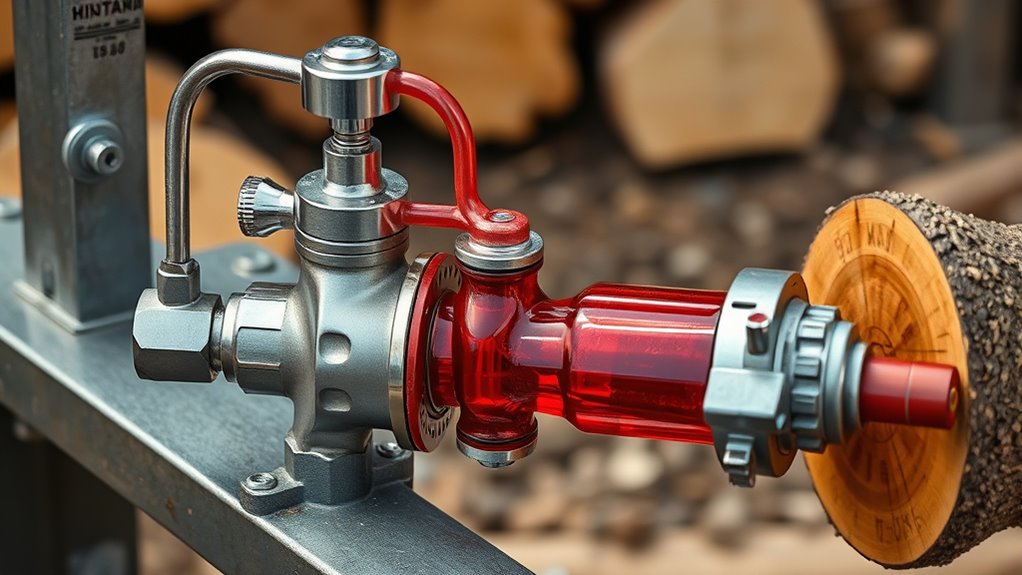
A hydraulic valve plays a crucial role in controlling the flow of hydraulic fluid within the log splitter’s system. It directs fluid to different parts of the machine, allowing you to operate it smoothly. When you activate the control lever, the valve opens or closes pathways, determining whether fluid moves to extend or retract the piston. This regulation ensures precise control over the splitting process, making your work safer and more efficient. The valve also helps maintain pressure within the system, preventing damage from over-pressurization. By switching the valve, you can stop the flow altogether, halting the piston’s movement. Overall, the hydraulic valve acts as the system’s command center, enabling you to control the power and direction of the hydraulic fluid with ease.
The Piston’s Movement and Log Splitting
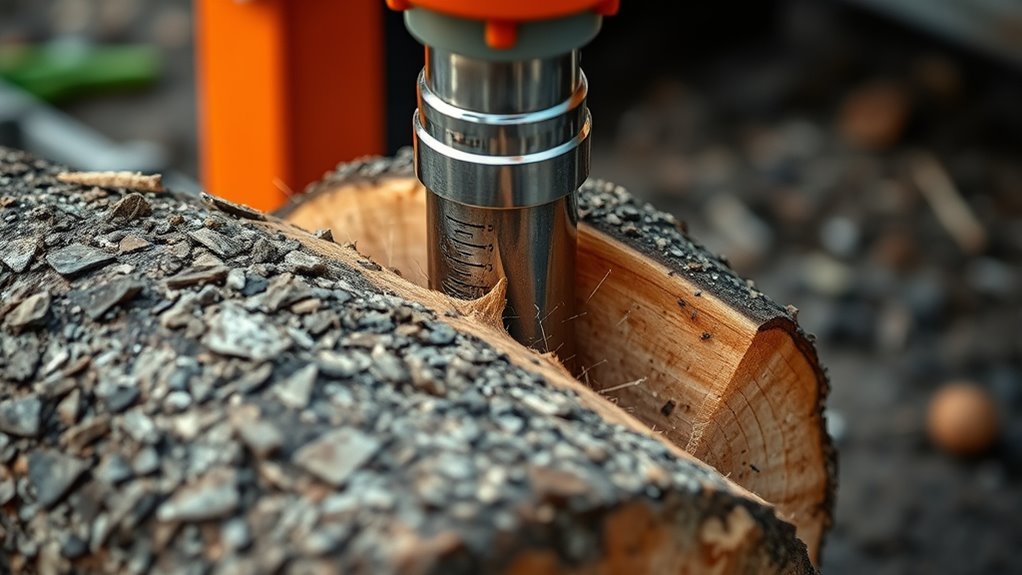
When the piston moves, hydraulic pressure drives it forward to split the log, and regulating this pressure is key to effective splitting. You can adjust the piston’s speed to guarantee smooth, safe operation and prevent damage. Understanding these pressure dynamics helps you get the most out of your hydraulic log splitter.
Hydraulic Pressure Dynamics
Understanding hydraulic pressure dynamics is essential to grasp how a log splitter’s piston moves and splits wood effectively. When you activate the splitter, hydraulic fluid is pumped into the cylinder under high pressure. This pressure pushes against the piston, forcing it forward with force proportional to the fluid’s pressure level. As the piston advances, it applies immense force to the log, overcoming its resistance and causing it to split. The pressure must be carefully maintained to guarantee consistent power without damaging the system. Once the log splits, the hydraulic pressure decreases, allowing the piston to retract. This cycle of building and releasing pressure drives the splitting process, ensuring efficient, controlled, and powerful operation every time you use the log splitter.
Piston Speed Control
Controlling the piston’s speed is essential for efficient and safe log splitting. When the piston moves too quickly, you risk damaging the log or causing unsafe handling. Conversely, if it moves too slowly, the process becomes inefficient and takes longer. Most hydraulic log splitters include a flow control valve that adjusts the rate of hydraulic fluid flow to the piston. By fine-tuning this valve, you can regulate the piston’s speed precisely. Faster movement applies more force quickly, ideal for soft logs, while slower speeds give you better control for tougher or more delicate splits. Proper piston speed control ensures maximum force application, reduces wear on components, and keeps you safe during operation. Adjusting the piston’s speed is a key step in mastering your log splitter.
Power Source and Motor Types
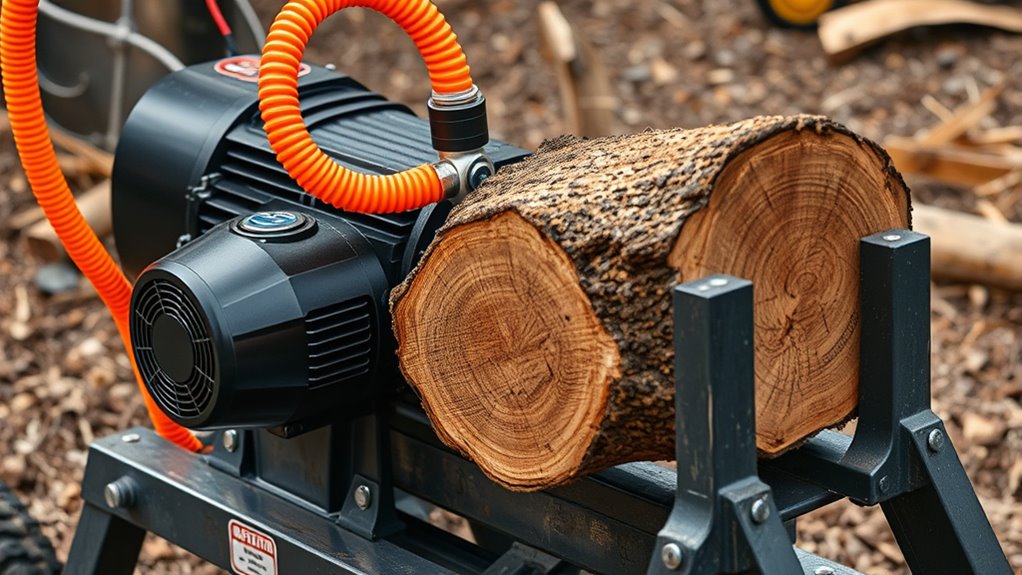
Hydraulic log splitters rely on various power sources and motor types to operate efficiently. Most commonly, gas engines provide mobility and power without needing an external power source, making them ideal for remote locations. Electric motors, on the other hand, are quieter, cleaner, and easier to maintain, often found in portable or indoor models. Some splitters use hydraulic motors powered directly by a hydraulic pump, which can be driven by either a gas engine or electric motor. The choice depends on your needs, with gas engines offering more power for larger logs and electric motors providing convenience and quieter operation. Understanding these options helps you pick the right log splitter for your specific requirements.
Safety Features in Hydraulic Log Splitters
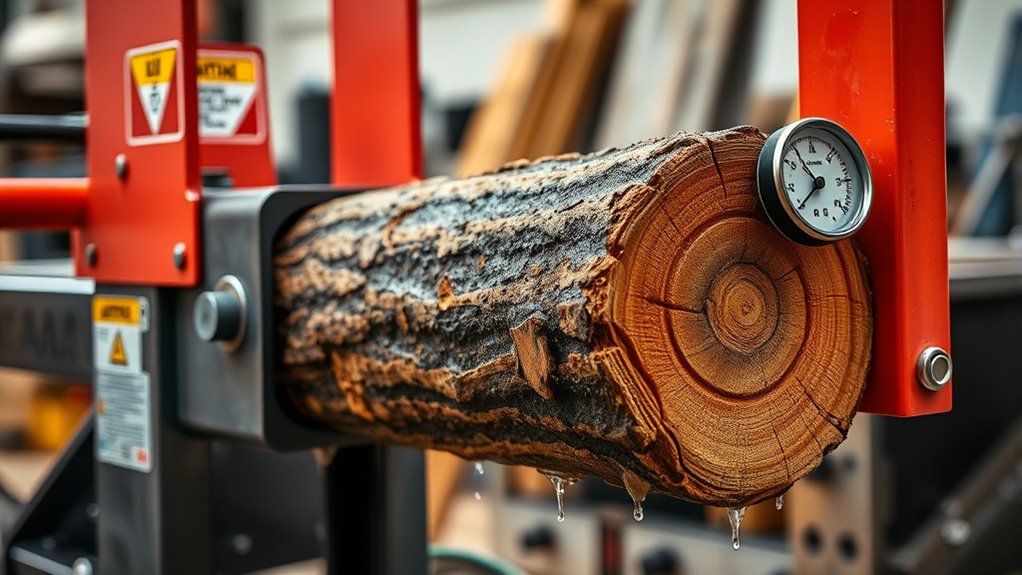
Safety features are essential components of hydraulic log splitters that help prevent accidents and injuries during operation. One key feature is the safety valve, which prevents excessive pressure buildup that could cause the machine to malfunction or explode. Many splitters also include a two-handed control system, requiring both hands to operate, keeping your hands away from moving parts. A retractable or emergency stop button provides quick shutdown if you notice unsafe conditions. Additionally, guards and shields cover dangerous parts like hydraulic rams and blades, reducing the risk of cuts or pinching injuries. Some models have automatic return valves that limit sudden movements, offering extra control. Always ensure these safety features are functional before use to protect yourself during operation.
Operating the Machine: Step-by-Step
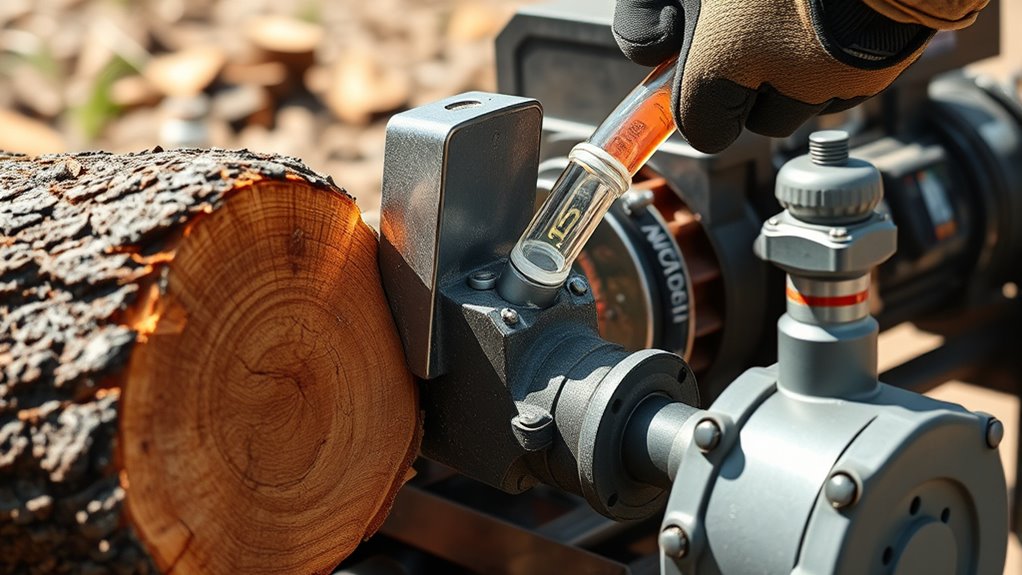
To operate a hydraulic log splitter safely and effectively, start by inspecting the machine to guarantee all safety features are in place and functioning properly. Check that the wedge is secure and the hydraulic hoses are undamaged. Make sure the area around the splitter is clear of obstacles and bystanders. Place the log correctly on the splitting platform, aligning it with the wedge. Engage the safety latch or lock if your machine has one. Grip the control lever firmly, then slowly push it forward to activate the hydraulic ram. The ram will push the log against the wedge, splitting it. Once the log is split, release the control lever to retract the ram. Always stay alert and avoid distractions during operation to prevent accidents.
Maintenance and Troubleshooting
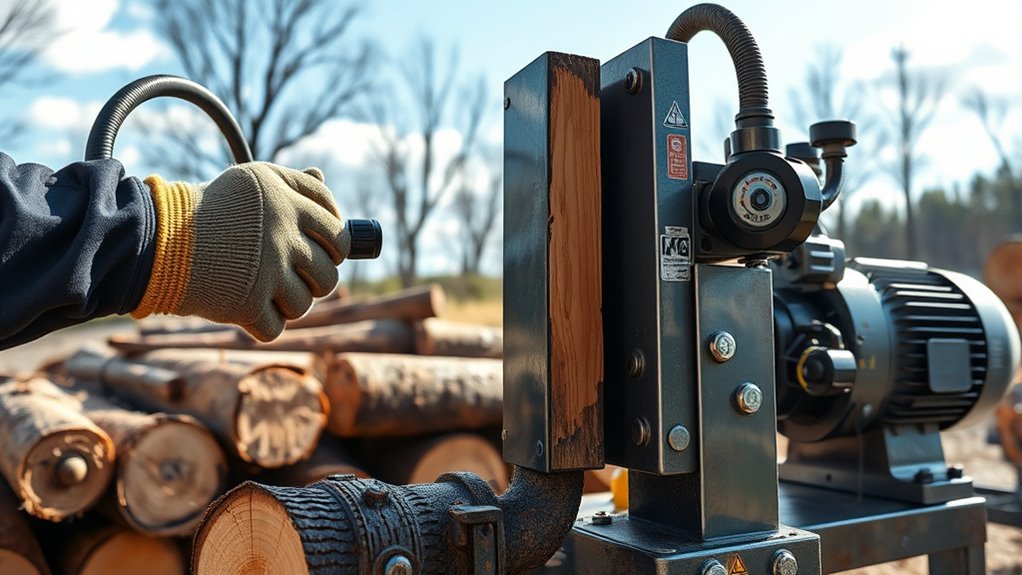
Regular maintenance is essential to keep your hydraulic log splitter operating smoothly and prevent costly breakdowns. Check hydraulic fluid levels regularly and top them off with the recommended fluid. Inspect hoses and fittings for leaks, cracks, or damage, replacing any worn parts promptly. Keep the splitting wedge and ram clean and lubricated to reduce wear. If the splitter isn’t functioning properly, ensure the hydraulic pump is working correctly and that the control valves aren’t clogged. Listen for unusual noises or slow operation, which could indicate a problem. Always follow safety protocols when troubleshooting or performing maintenance. If issues persist, consult the manufacturer’s manual or contact a professional technician. Proper upkeep guarantees your splitter remains reliable and safe to use.
Frequently Asked Questions
How Does the Hydraulic System Prevent Over-Pressurization?
Think of the hydraulic system as a safety net catching excess pressure. You prevent over-pressurization by using a pressure relief valve that automatically opens when pressure gets too high, releasing the excess fluid. This acts like a pressure release valve on a steam cooker, ensuring safety and protecting the machine from damage. Regularly checking and maintaining this valve keeps your log splitter running smoothly and safely.
What Types of Logs Are Hydraulic Splitters Unable to Process?
You might wonder what logs hydraulic splitters can’t handle. Typically, they struggle with very hard or knotted logs, which require more force than the machine can generate. Additionally, extremely large or oversized logs may be too heavy or thick for the splitter’s capacity. Soft or rotten logs are usually easy to process, but always check your machine’s specifications to avoid damage or safety issues.
How Energy-Efficient Are Hydraulic Log Splitters?
Hydraulic log splitters are quite energy-efficient, especially compared to manual methods. You use less power because the hydraulic system maximizes force with minimal effort. When you operate one properly, it converts energy directly into splitting power, reducing waste. Plus, features like adjustable flow control help you optimize energy use for different log sizes. Overall, they’re a smart choice if you want effective splitting without high energy costs.
Can Hydraulic Log Splitters Operate in Cold Weather Conditions?
Imagine you’re in the Wild West, facing a cold morning—can your hydraulic log splitter handle it? Yes, most hydraulic log splitters operate well in cold weather, but extreme temperatures can thicken hydraulic fluid, slowing performance. To keep things running smoothly, you might need to use winter-grade fluid or add a heater. Regular maintenance and proper fluid choice make certain your splitter works reliably, no matter how frosty the day gets.
What Are the Environmental Impacts of Hydraulic Fluid Leaks?
You might wonder about the environmental impacts of hydraulic fluid leaks. When leaks occur, the fluid can contaminate soil and water, harming plants, animals, and aquatic life. It can also pose health risks if it comes into contact with skin or is ingested. To prevent this, you should regularly inspect your equipment, fix leaks promptly, and use environmentally friendly hydraulic fluids to minimize ecological damage.
Conclusion
Now that you know how a hydraulic log splitter works, you can appreciate its quiet strength and reliability. With proper care and respect for safety, you’ll find it a helpful partner in your wood-splitting tasks. Think of it as a trusted helper, gently making your work easier and more enjoyable. By understanding its inner workings, you’re better equipped to keep it running smoothly, turning a sometimes tough job into a more pleasant, rewarding experience.
